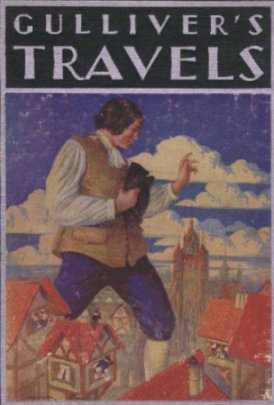¡@
JONATHAN SWIFT
|
¡@ Source: Portraits of Jonathan Swift |
Genealogical resources: Jonathan Swift |
Swift
was a man of affairs who became a writer because literature was a way
of getting affairs directed. His method was to expose a sham or evil
by setting up a more outrageous evil against it, and defending the
latter with serious irony.
William Wycherly, John Dryden, George Etherege, William Congreve, Oliver
Goldsmith and Richard Sheridan are often cited as exemplary playwrights of
the comedy of manners.
Beyond the art of Congreve, Restoration comedy of manners could not
advance. Its essential excellences and its essential limitations were
completely realized in his work. In brilliant dialogue, in vivid contrasts
of social types, in the expression of that eager, yet formal urbanity of
temper which characterized Restoration society at its best, Congreve
triumphed over all other comic dramatists of his age (Kathleen Lynch 217).
Gulliver's Travel (1726)
|
¡@ Source: Gulliver's Travels |
Summary |
Pt.
I:
Lemuel Gulliver, a ship's surgeon, is shipwrecked at Lilliput where
the inhabitants are six inches tall, except their emperor who is taller by
almost the "breadth of my nail" than any of his court. Swift
satirizes war by showing how seriously the little people wage it, and has
harsh words for the politicians and government officials. The parties are
known by the height of their heels; a dispute over the question at which
end an egg should be broken is enough to plunge Lilliput into a civil war.
Pt.
II:
In Brobdingnag, the natives are as tall in proportion to Gulliver
as the Lilliputians were short. He engages in lengthy discussions with the
king, who cannot understand the lofty pretentions and vanities of the
warfare; what he hears strikes the king with horror.
Pt.
III:
In Laputa, men abandon all common sense and concern themselves with
speculative philosophy. In Lagado, the flying island, Gulliver is amazed
to see the scientists trying to extract sunbeams from cucumbers.
Pt.
IV:
Gulliver visits the land of the Houyhnhnms, where intelligent
horses are the masters and the Yahoos, filthy, degenerate human beings,
are the slaves. At last, Gulliver returns to his wife and family, but
finds them impossible to live with, after having associated with the
Houyhnhnms. The yahoos represented for Gulliver the worst to which human
beings could descend.
1. In the letter Captain Gulliver wrote to his cousin Sympson, how is Gulliver presented?
2. In Lilliput, Lemuel Gulliver is charmed by Lilliputians at first, but later feels disgusted. Why? Give examples.
3. In Lilliput, how do you see the Lilliputian Emperor? And Flimnap and Bolgolam?
4. In Gulliver's voyage to Lilliput, how does Swift portray Gulliver's character?
5. How is the King of Brobdingnag portrayed? How about the Queen? What does Gulliver offer to the king? In this act how is Gulliver changed?
6. Who are the Struldbruggs? Are they happy to have eternal life? Why or why not?
7. Describe the Houyhnhnms and Yahoos. What are their strength and weakness? What is your attitude toward them?
8. Who is Captain Pedro De Mendez? Why does Swift put him at the end of the book?
9. How does Swift describe women in Gulliver's Travels?
10. How would you compare Gulliver's Travels with More's Utopia since these two
works invent an ideal imaginary state and
satirize one's own society?
1.
At the beginning and end of each of the four Parts of Gulliver's
Travels Swift locates Gulliver's travels in a familiar world with
exact geographical references etc. What is the effect of this realistic
style on the reader?
2.
How does the realistic style establish the narrator's persona and
what are Gulliver's qualities as a narrator? Are you inclined to believe
him and do you want to hear more?
3.
What is the reader's
impression of the Lilliputians--at the beginning? Later? Find the
reason that cause the reader's change of opinions.
4.
Discuss the size
discrepancies in Gulliver's
Travels. What does Swift suggest by the smallness of the Lilliputians
and the big size of the Brobdingnagians?
5.
Size discrepancies point to the relativism
of human nature. Find passages that show how Swift satirizes by
treating humanity as malformed and diseased, both in body and soul, which
is one of the conventions of satire.
6.
Gulliver never explains conditions in England to the Lilliputians
as he does in Part II to the Brobdingnagians. What may be his (the
author's) reason?
7. Summarize your understanding of Swift's method of narration. How does Gulliver function as a foil to the Lilliputians and to the Brobdingnagians and by what exactly does the author achieve satiric effect?
Gulliver's Travel by Jonathan Swift
Comparing Utopia and Gulliver's Travels
¡@
| Medieval Period | 16th Century | 17th Century | Restoration and 18th Century | English Department Homepage |


